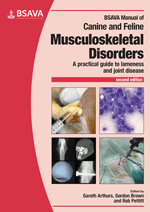
Full text loading...

For any animal, motion is required for it to function and enjoy a reasonable quality of life; the aim of orthopaedic surgery is to restore this function with minimal associated pain. This chapter details patient assessment, clinical decision-making, surgical principles, preparation for surgery and execution of a range of articular surgeries.
Principles of orthopaedic surgery, Page 1 of 1
< Previous page | Next page > /docserver/preview/fulltext/10.22233/9781910443286/9781910443286.13-1.gif

Full text loading...











